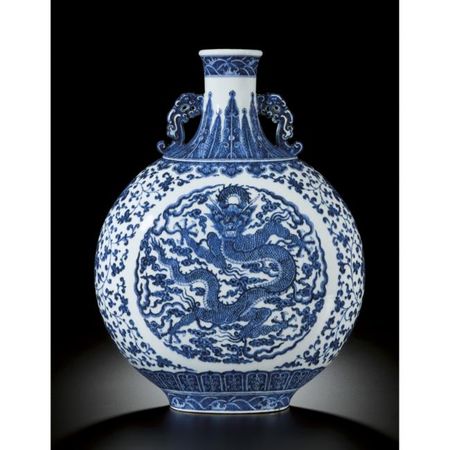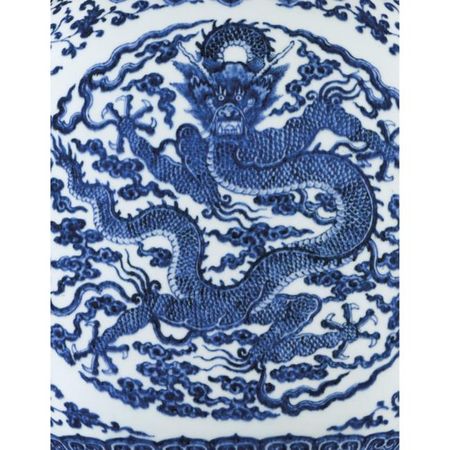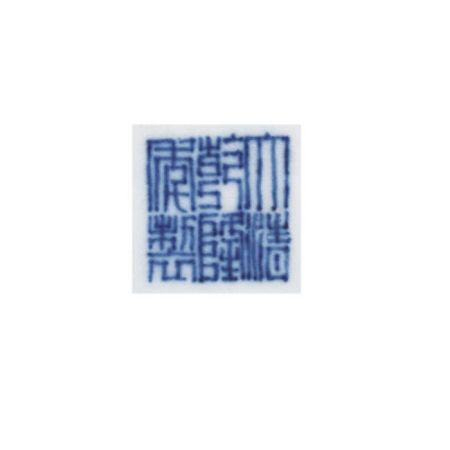A superb and rare large blue and white 'dragon' moonflask. Seal mark and period of Qianlong
A superb and rare large blue and white 'dragon' moonflask. Seal mark and period of Qianlong
the well potted body of flattened globular form, superbly painted on each side in vivid tones of cobalt-blue with simulated 'heaping and piling' with a medallion enclosing a ferocious full-faced dragon, the scaly five-clawed beast framed by flaring horns and flowing mane, leaping amidst swirling vaporous clouds and flames, the medallion reserved on a ground of scrollwork issuing three large lotus blooms extending up each side, all set between a ruyi collar at the shoulder and lotus lappet and rolling wave bands around the base, the waisted neck flanked by a pair of moulded archaistic phoenix curling into 'S'-shapes and decorated with a band of upright plantain leaves, all below a band of foaming waves at the everted lipped rim, inscribed on the base with the six-character seal mark in underglaze-blue. 45.5 cm., 17 7/8 in. Est. 15,000,000—20,000,000 HKD. Sold 39,860,000 HKD
An Exemplary Work for the Qianlong Emperor
By Regina Krahl
The wish to justify their right to the throne of China as a foreign dynasty made the Manchu emperors of the Qing dynasty (1644-1911) particularly reverent of antiquity and eager to symbolically manifest the power and beneficence of the emperor through works of art. The present moonflask, lot 1701, is an archetypal and exemplary product of imperially commissioned Qing art.
Its shape and its painting style both provide an immediate reference to the great works of art of the past, while the dragon yields an impressive evocation of imperial grandeur. As emblem of the Emperor's majestic role and benevolent rule the dragon had of course a long tradition in China; yet probably no other ruler made such calculated propagandistic use of it as the Qianlong emperor (r. 1736-95). In the Qing palace, dragons could be seen everywhere and the image of the frontal-faced five-clawed imperial dragon in particular can be considered as the ultimate reflection of the Qianlong Emperor's imperial splendour.
The shape of the present flask inevitably calls to mind the moonflasks of the early Ming (1368-1644) reigns of Yongle (1403-24) and Xuande (1426-35), the greatest period for the production of blue-and-white porcelain. Dragons had appeared rather rarely on moon flasks before the Qianlong reign, but a few examples exist already from the early Ming period. At that time the image of the frontal dragon was not yet in use and the dragon was shown sideways; see, for example, a piece from the Edward T. Chow and T.Y. Chao collections, included in the exhibition Zhongguo ming tao Riben xunhui zhan [Exhibition of famous Chinese ceramics touring Japan], National Museum of History, Taipei, 1992, pp.118-121, illustrated on the slip case, and published again in Sotheby's: Thirty Years in Hong Kong, Hong Kong, 2003, pl. 205.
Ming dynasty moonflasks began to be copied on a larger scale in the Yongzheng reign (1723-35), when the whole repertoire of Yongle forms was reproduced. The Yongzheng versions generally follow the Ming shapes rather closely, either with a flat base and no foot, or a central raised boss, or a garlic-head mouth, while in the present version the shape has been modified. In the Qianlong reign the potters of the imperial kilns appear to have been more interested in diversifying handle shapes than in details of the vessels' silhouette, and animal, bird and plant forms, often archaistic in style, were created. The present handle shape may be one of the earliest of this type to have been developed. It can be traced back to the Yongzheng reign, but at that time it represented a great exception, as otherwise at that time handles were far simpler, generally of plain loop or scroll form, or were lacking altogether.
The prototypes for the handles seen here appear on a very unusual blue-and-white flask of Yongzheng mark and period, where they have simply been added to a handle-less early Ming moon flask shape (Chinese Porcelain. The S.C. Ko Tianminlou Collection, Hong Kong Museum of Art, 1987, no. 54). Although at first glance they appear very close to the present ones, the Yongzheng handles in fact depict dragons and lingzhi, while in the Qianlong version the longevity fungus emerges from a phoenix head. As phoenix handles they became very popular in the Qianlong period, when examples, perhaps from this same mould, could also be applied the other way round and the holes are not always pierced, but sometimes filled with glaze; see a flask from the Huaihaitang collection, included in the exhibition Ethereal Elegance. Porcelain Vases of the Imperial Qing, Art Museum, The Chinese University of Hong Kong, 2007, cat.no.94.
Even the painting style of the early Ming period was in the Qing consciously recreated. The porcelain painters of the 18th century were so enamoured with the appearance of early 15th-century blue-and-white that they developed a special painting manner to imitate the accidental imperfections of their models, namely by recreating the so-called 'heaped and piled' effect of darker spots of cobalt blue through deliberate uneven dotting.
The design of the present flask is otherwise very rare, although one companion piece in the Palace Museum, Beijing, from the Qing court collection is published in The Complete Collection of Treasures of the Palace Museum. Blue and white Porcelain with Underglazed Red (III), Shanghai, 2000, pl.132 (Fig. 1), where the piece is related to a Qianlong order of 1738 to copy a Xuande blue-and-white flask. Another Qianlong flask of this design was sold in these rooms 29th October 2001, lot 543.
In the Qianlong reign dragon-decorated blue-and-white moon flasks existed also in a smaller version, with curly handles, with a full-faced dragon depicted rising above waves, as illustrated in Qingdai ciqi jianding [Appraisal of Qing porcelains], Shanghai, 1994, pl. 159; and in a somewhat larger version with a dragon depicted sideways facing a smaller one rising from waves, for example, in the Matsuoka Museum of Art, Tokyo, illustrated in Sekai tōji zenshū/Ceramic Art of the World, vol. 15, Tokyo, 1983, pl. 152, and sold in our London rooms 13th March 1973, lot 269.
Blue-and-white flasks of the same shape and basic design as the present example are also known with the circular panels on each side depicting dragon and phoenix chasing a flaming pearl; a pair of flasks of this design is recorded, both sold in these rooms, 2nd May 2005, lot 510 and 23rd October 2005, lot 212; and the Tianminlou collection contains a moonflask of this form, varying slightly in its painting manner, where a composite flower scroll design around the central part of the flask replaces the dragon roundels (Chinese Porcelain. The S.C. Ko Tianminlou Collection, Hong Kong Museum of Art, 1987, no. 65).
Sotheby's. Fine Chinese Ceramics & Works of Art. 08 Oct 09. Hong Kong www.sothebys.com

/https%3A%2F%2Fprofilepics.canalblog.com%2Fprofilepics%2F1%2F0%2F100183.jpg)







/http%3A%2F%2Fstorage.canalblog.com%2F43%2F34%2F577050%2F65866509_o.jpg)
/http%3A%2F%2Fstorage.canalblog.com%2F40%2F54%2F119589%2F65372473_p.jpg)
/http%3A%2F%2Fstorage.canalblog.com%2F58%2F42%2F119589%2F64502049_p.jpg)
/http%3A%2F%2Fstorage.canalblog.com%2F80%2F95%2F119589%2F64330603_p.jpg)